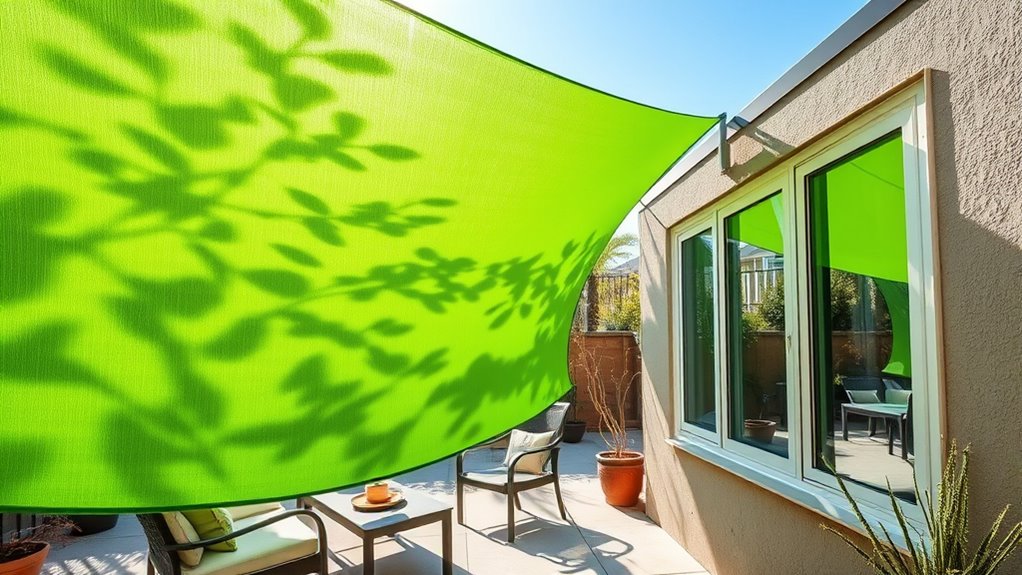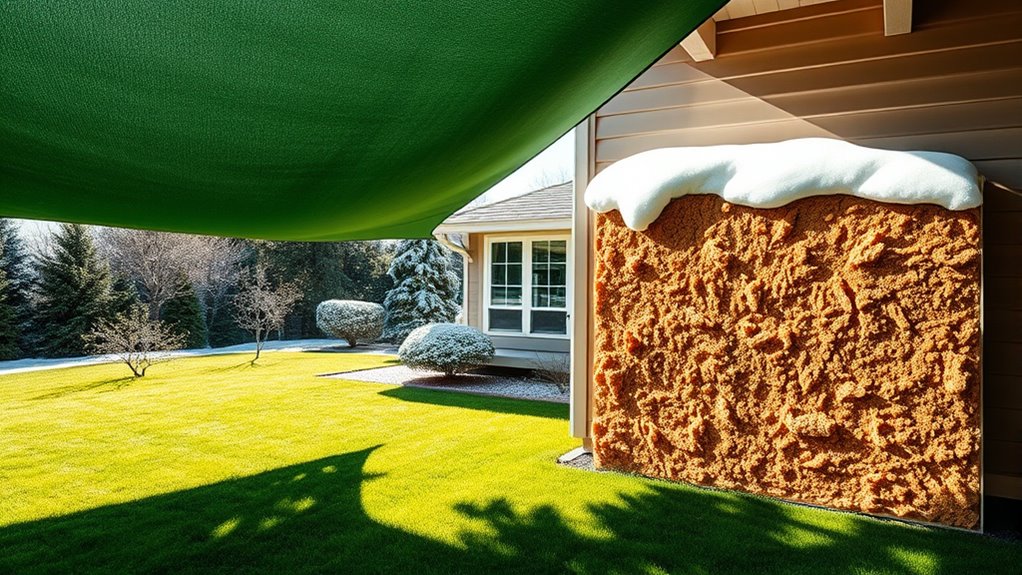To optimize your home year-round, use shade cloth in summer to block heat, reduce glare, and protect outdoor furniture from sun damage. In winter, install insulation to keep warmth inside, lower heating costs, and prevent heat loss. These seasonal adjustments improve comfort, extend furniture lifespan, and save energy. Making these changes can considerably impact your living environment, and if you explore further, you’ll discover even more ways to adapt and enhance your space throughout the seasons.
Key Takeaways
- Shade cloth reduces outdoor heat and glare during summer, protecting furniture and enhancing outdoor comfort.
- Insulation retains indoor warmth in winter, lowering heating costs and maintaining a consistent indoor temperature.
- Seasonal adjustments like shading and insulation extend the lifespan of outdoor furniture and indoor structures.
- Proper maintenance of outdoor and indoor items, including cleaning and inspection, improves durability across seasons.
- Managing water drainage and energy efficiency are crucial seasonal strategies for a comfortable, cost-effective home.

Have you ever wondered why economic data can fluctuate throughout the year? The same principle applies to your home and outdoor spaces. Seasonal adjustments matter, especially when it comes to maintaining comfort and efficiency. During summer, shade cloth becomes your best friend, helping you stay cool and protecting your outdoor furniture from sun damage. Proper outdoor furniture care involves using shade cloth to prevent fading, cracking, or warping caused by prolonged sun exposure. Installing shade cloth isn’t just about comfort; it’s a practical step to extend the lifespan of your outdoor pieces. It also reduces the need for frequent cleaning and maintenance, which can be time-consuming and costly. Incorporating protective measures like shade cloth can also help prevent UV damage to other outdoor items, such as fabrics and plastics. In winter, the focus shifts to insulation. As temperatures drop, insulating your home becomes essential to keep warmth inside and reduce heating costs. Think of insulation as a form of seasonal adjustment—just like you’d switch from short-sleeve shirts to sweaters, you modify your home’s thermal efficiency. Proper insulation helps maintain a consistent indoor temperature, which means you’re less likely to overuse your heating system. This not only saves money but also preserves the integrity of your home’s structure over time. When considering seasonal adjustments, don’t forget about your solar panels. During winter, snow and dirt can reduce their efficiency, so regular solar panel maintenance is vital. Cleaning and inspecting your panels ensure they operate at maximum efficiency, capturing as much sunlight as possible despite shorter days and cloudier weather. Additionally, some wicks used in candles, like those in wickless candle making, can be affected by temperature changes, emphasizing the importance of seasonal adjustments in home maintenance. Furthermore, understanding how to optimize your home energy usage can lead to significant savings and increased comfort during seasonal transitions. Proper drainage management is also crucial to prevent water damage during rainy seasons, which can be an overlooked aspect of seasonal adjustments. The concept of seasonal adjustments extends beyond just comfort; it impacts the longevity of both your outdoor and indoor investments. For example, when summer arrives, applying shade cloth not only keeps your outdoor space more livable but also reduces the wear and tear on outdoor furniture. Conversely, winter insulation keeps everything warm and functioning properly inside. These adjustments are simple but effective ways to adapt to seasonal changes, helping you save money and increase the durability of your belongings. Whether it’s protecting outdoor furniture, maintaining solar panels, or insulating your home, understanding and implementing seasonal adjustments makes a noticeable difference. It’s about being proactive rather than reactive, ensuring you’re prepared for the fluctuations in weather and energy needs that come with each season. By doing so, you create a more comfortable, efficient living environment year-round, all while extending the life of your investments. Recognizing the benefits of seasonal adjustment strategies can significantly enhance your home’s resilience and efficiency across different climates and weather conditions.
Frequently Asked Questions
How Do I Choose the Right Shade Cloth for Summer?
When choosing the right shade cloth for summer, consider its UV protection to shield your space from harsh rays. You also want good breathability features so heat and humidity can escape, keeping the area cooler. Look for materials designed to block out a significant amount of sunlight while allowing air to circulate. This way, you’ll stay comfortable and protected during hot summer days, creating a pleasant outdoor environment.
What Types of Insulation Are Best for Winter?
When choosing insulation for winter, you want thermal barriers that keep heat inside your space efficiently. Look for materials with high insulation durability, like foam boards, spray foam, or insulated panels, which resist moisture and maintain their insulating properties over time. These options help reduce heat loss, keep your home warmer, and save energy. Make certain the insulation you select is suitable for your climate and installation needs for long-lasting warmth.
Can I Use the Same Materials Year-Round?
You might wonder if you can use the same insulation materials year-round for DIY installation. While some materials like foam boards are durable and suitable in all seasons, others like fiberglass may lose effectiveness or degrade over time with exposure to moisture or temperature changes. It’s best to choose insulation with strong material durability, and consider seasonal adjustments like shade cloth in summer or insulation in winter to optimize comfort.
How Do Seasonal Changes Affect Energy Savings?
Imagine your energy bills as a fluctuating tide—you can ride the waves or be overwhelmed. Seasonal changes impact your savings by affecting solar panel efficiency and heating and cooling costs. In summer, shade cloth reduces cooling expenses, while winter insulation cuts heating costs. Adapting your strategies guarantees consistent energy savings year-round, turning seasonal shifts from obstacles into opportunities to optimize your home’s comfort and efficiency.
Are There Maintenance Tips for Seasonal Adjustments?
For seasonal adjustments, you should perform regular seasonal inspections to guarantee your shade cloth and insulation remain effective. Check for tears, wear, or material deterioration that could reduce their durability. Clean and secure your shade cloth before summer, and inspect insulation for gaps or damage before winter. Proper maintenance helps prolong material durability, ensuring your adjustments continue to provide energy savings and comfort year-round.
Conclusion
As seasons shift, stay savvy by switching shades and snug layers. Shade cloth shields you from scorching summer sun, while winter’s insulation keeps warmth within. Seamlessly switch, saving energy and ensuring comfort all year round. By balancing brightness with coziness, you’ll bask in the beauty of each season’s benefits. So, stay spirited, stay snug, and let seasonal strategies subtly sculpt your space into a sanctuary of comfort and care.









